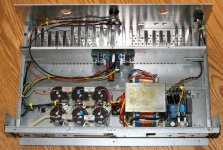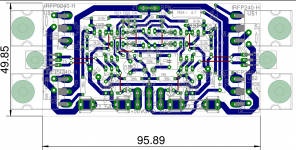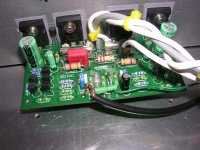Hi All,
i've read about Greg ball's popular GB150 amp a few years ago...
and just recently was thinking about one again...
upon trying to go to the ska-audio site, i noticed it was gone....
greg's not doing this anymore, emailed him to confirm....
I was wondering if there any verified kits which exist on the interwebs?
all i could see was a thread for something based on the GB150...caled the tg7? on diyaudio.
i was hopping there were pre-build modules which i could take to a tech to wire up/box for me (seeing as my diy skills are still not at the mains powered level yet! )
i've read about Greg ball's popular GB150 amp a few years ago...
and just recently was thinking about one again...
upon trying to go to the ska-audio site, i noticed it was gone....
greg's not doing this anymore, emailed him to confirm....
I was wondering if there any verified kits which exist on the interwebs?
all i could see was a thread for something based on the GB150...caled the tg7? on diyaudio.
i was hopping there were pre-build modules which i could take to a tech to wire up/box for me (seeing as my diy skills are still not at the mains powered level yet! )
Hi Snakeoilphile,
Jim's Audio still sells PCBs for the GB150D. Bigun did an improved design many years ago. J Lester electronics did a different PCB based on the GB150D that included a dc detector as well. No one offers kits as far as I am aware. Hope you can find someone who might part with their finished boards. If not then buy the Jim's Audio boards. They usually supply the circuit diagram as well.
Cheers
Jim's Audio still sells PCBs for the GB150D. Bigun did an improved design many years ago. J Lester electronics did a different PCB based on the GB150D that included a dc detector as well. No one offers kits as far as I am aware. Hope you can find someone who might part with their finished boards. If not then buy the Jim's Audio boards. They usually supply the circuit diagram as well.
Cheers
Isn't the TG7 Bigun's effort?
I wouldn't recommend the Jim's boards to someone not a little experienced because they need a bit of tweaking to get working I believe. They aren't the same as the original boards and use some different parts.
Snakeoilphile, my main amp is a GB150 using boards purchased from Greg (but not pre-built) and while it's excellent, I think there are plenty of other options on this forum that members here have compared favourably with the SKA. I'd have a look round for other pre-built modules offered.
I wouldn't recommend the Jim's boards to someone not a little experienced because they need a bit of tweaking to get working I believe. They aren't the same as the original boards and use some different parts.
Snakeoilphile, my main amp is a GB150 using boards purchased from Greg (but not pre-built) and while it's excellent, I think there are plenty of other options on this forum that members here have compared favourably with the SKA. I'd have a look round for other pre-built modules offered.
Last edited:
Member
Joined 2009
Paid Member
I can confirm that I made a design based on the SKA. The details are in this thread: TGM7 - an amplifier based on Greg Ball SKA
It's essentially the SKA design but I did make some improvements, the most important of which was to design a compact 'modern' PCB. I posted the design into the SKA forum, into a thread that started when Greg made the schematic public - it had been kept secret for most of it's life, so Greg was also aware of my efforts.
The amplifier is still running, I have it set up as a mono amp (in a chassis I designed to host 3 channels eventually) which I use when I want a 'guaranteed low distortion neutral' amplifier with plenty of output power.
It's all a hobby for me, I don't 'sell kits' but if you are willing to build your own I can help you obtain PCBs (send me a PM). My PCBs use SMD for the two-terminal parts - which are very easy to install, let me say again - don't be afraid of SMD parts when they are limited to 2-terminal parts and are relatively large. They are not difficult to hand solder, in some regards I find it easier, neater and preferable to through-hold parts. The result is a compact board which has a much more optimal layout than the original, it is stable with a very wideband feedback network.
It's essentially the SKA design but I did make some improvements, the most important of which was to design a compact 'modern' PCB. I posted the design into the SKA forum, into a thread that started when Greg made the schematic public - it had been kept secret for most of it's life, so Greg was also aware of my efforts.
The amplifier is still running, I have it set up as a mono amp (in a chassis I designed to host 3 channels eventually) which I use when I want a 'guaranteed low distortion neutral' amplifier with plenty of output power.
It's all a hobby for me, I don't 'sell kits' but if you are willing to build your own I can help you obtain PCBs (send me a PM). My PCBs use SMD for the two-terminal parts - which are very easy to install, let me say again - don't be afraid of SMD parts when they are limited to 2-terminal parts and are relatively large. They are not difficult to hand solder, in some regards I find it easier, neater and preferable to through-hold parts. The result is a compact board which has a much more optimal layout than the original, it is stable with a very wideband feedback network.
Attachments
Last edited:
Gareth, I wouldn't mind getting a couple of your boards. I'd been thinking of a dual amp setup for a passive line level crossover and they'd make a nice match for my SKA.
I recently re-read that GB150 thread discussing Jim's boards and was reminded of your effort.
EDIT: Hmmm, maybe your TGM8 might be better! I've just had a look at that thread...
I recently re-read that GB150 thread discussing Jim's boards and was reminded of your effort.
EDIT: Hmmm, maybe your TGM8 might be better! I've just had a look at that thread...
Last edited:
Member
Joined 2009
Paid Member
Snakeoilphile, maybe ask in a new targeted thread the Solid State forum for recommended amps that some vendor supplies pre-built. I think even Jim's supplies some well known amps in built modules. I once sold some immaculate MyRef RevC boards I'd built and hadn't even powered up, so you might even get someone here that offers something. I really regret selling these actually - but I'd just had brain surgery and wasn't in the right mind to finish building amps!
Hey Gareth, I'll have to think what I want to do. Are both pretty much sorted and stable designs now? I gotta say I'm impressed by your output.
Hey Gareth, I'll have to think what I want to do. Are both pretty much sorted and stable designs now? I gotta say I'm impressed by your output.
Last edited:
I have a pair of GB150 assembled boards built from the original Greg Ball kits, which are surplus to requirements. They work fine, although I always add an outboard inductor/resistor just to be on the safe side.
Unfortunately I'm on the other side of the world to you.
Just one word of caution... I didn't find GB's method of thermal feedback to be ideal. These amps need a decent heatsink to avoid thermal runaway.
Unfortunately I'm on the other side of the world to you.
Just one word of caution... I didn't find GB's method of thermal feedback to be ideal. These amps need a decent heatsink to avoid thermal runaway.
Member
Joined 2009
Paid Member
Hi Stuey,
My output has been close to zilch since 2016, but I tinker when I can.
Both amps are stable as far as I know, but I’ve not done a lot of testing as this is just a hobby for me. The TGM 7 has been in use without issue, solid as far as it goes. I’ve never thrashed it hard, it’s simply too darn loud already. The TGM8 has had no use as I never got a chance to build it into a finished enclosur, but I still have a pair of them waiting for the day. However, others have built the amp and those who got it up and running have yet to report back to me any issues. Again, there’s been no hard test regime, no idea if it would fail gracefully if abused. To my ears, the TGM8 is the better amp. Good enough in fact that I consider it beyond my ability to better it. As Harry Callahan would say, a man has gotta know his limitations.
My interest now would be to explore other designs only out of scientific curiosity or as a kind of industrial archeology in recreating some famous amps from the past.
My output has been close to zilch since 2016, but I tinker when I can.
Both amps are stable as far as I know, but I’ve not done a lot of testing as this is just a hobby for me. The TGM 7 has been in use without issue, solid as far as it goes. I’ve never thrashed it hard, it’s simply too darn loud already. The TGM8 has had no use as I never got a chance to build it into a finished enclosur, but I still have a pair of them waiting for the day. However, others have built the amp and those who got it up and running have yet to report back to me any issues. Again, there’s been no hard test regime, no idea if it would fail gracefully if abused. To my ears, the TGM8 is the better amp. Good enough in fact that I consider it beyond my ability to better it. As Harry Callahan would say, a man has gotta know his limitations.
My interest now would be to explore other designs only out of scientific curiosity or as a kind of industrial archeology in recreating some famous amps from the past.
Last edited:
I have a pair of GB150 assembled boards built from the original Greg Ball kits, which are surplus to requirements. They work fine, although I always add an outboard inductor/resistor just to be on the safe side.
Unfortunately I'm on the other side of the world to you.
Just one word of caution... I didn't find GB's method of thermal feedback to be ideal. These amps need a decent heatsink to avoid thermal runaway.
hey dave, from what i've read on greg's site years ago, he does very very addamently that the amp needs proper heat sinking.
He is certainly right!
I prefer to make an amp thermally stable i.e. bias current is ~constant with temperature. Then use >adequate heatsinking.
The GB150 needs >>adequate heatsinking because overall is has a positive temp coefficient. It will certainly work Ok like this, but it's not an elegant solution... but I'm sure Greg would say "who gives a damn?".
I prefer to make an amp thermally stable i.e. bias current is ~constant with temperature. Then use >adequate heatsinking.
The GB150 needs >>adequate heatsinking because overall is has a positive temp coefficient. It will certainly work Ok like this, but it's not an elegant solution... but I'm sure Greg would say "who gives a damn?".
Dave, did you use the diode connected BD transistor piggybacked onto the outputs, or the original setup with TO92's inserted into a hole in the heatsink? I think the latter had a slower response to temp change.
I've absolutely hammered my SKA amp for hours on occasion and it has proved very reliable, and I only have 'normal' heatsinking; nothing exceptional or deliberately oversized. Once was at an outdoor party on a 40 degree C day, too! I remember because I was checking the amp vents to see how warm it was getting.
I've absolutely hammered my SKA amp for hours on occasion and it has proved very reliable, and I only have 'normal' heatsinking; nothing exceptional or deliberately oversized. Once was at an outdoor party on a 40 degree C day, too! I remember because I was checking the amp vents to see how warm it was getting.
Last edited:
Member
Joined 2009
Paid Member
The amp is thermally stable by design, it’s only the physical construction that could be the issue. A decent sized heatsink is still a good idea. My version is slightly different as those diode wired transistors are not required. In my version the heat sensors are mounted directly in contact with the power devices in a compact arrangement.
That's your problem then I'd say. Greg's initial recommendation was to drill a hole in the sink so the TO92 was a very close fit, then use thermal grease. Then around the time I bought my boards, most builders were using the piggyback method alternatively recommended by Greg to make the feedback loop more effective and the bias more stable. There was certainly an issue with bias wavering but I know of no-one on the SKA forum that had runaway issues or of anyone using unusually big sinks. Then I believe the bias issue was properly fixed with the addition of a couple of 0.15R resistors on the outputs, in a later PCB version.
Member
Joined 2009
Paid Member
Here it is, I have not build it yet but plse do and let us know how it goes !
I have all the spares, lots of people love it.
I have all the spares, lots of people love it.
Attachments
- Home
- Amplifiers
- Solid State
- SKA AMPS GB150 kits/complete build


